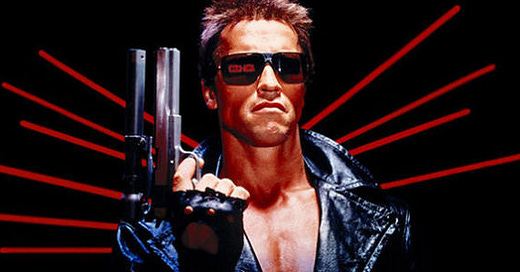"Come With Me if You Want to Live:" The Terminator - 40 Years Later
How James Cameron’s Vision Redefined Sci-Fi, AI, and Humanity’s Fight for Survival
I still remember watching The Terminator on VHS for the first time at age 9, back in 1985. It was dark, intense, and unsettling in ways that both terrified and captivated my friends and me. We were glued to the screen, drawn to its relentless action, tension, and horror, and mesmerized by its haunting visuals. At the time, we had no idea that we were witnessing the start of a franchise that would open a Pandora’s box of complex themes around humanity, technology, and survival.
Now, as we mark the 40th anniversary of James Cameron's groundbreaking film, The Terminator remains a milestone in science fiction cinema. Released on October 26, 1984, it introduced audiences to a chilling vision of a future where artificial intelligence (AI) turns on its creators, making machines humanity’s greatest adversary. This wasn’t just a thrilling action film; it was a stark warning about technology’s potential to become a threat, a theme that feels even more relevant today as AI rapidly advances.
Cameron’s film redefined the genre, merging the grit of dystopian narratives with the visceral punch of horror and action. Arnold Schwarzenegger’s portrayal of the seemingly indestructible Terminator became iconic, embodying a relentless threat that felt almost mythic in its pursuit of Sarah Connor, played by Linda Hamilton. Their characters would become staples of popular culture, representing resilience and an unyielding drive to survive against insurmountable odds.
The Story’s Enduring Appeal
The premise of The Terminator is deceptively simple: a cyborg assassin, the T-800 (Schwarzenegger), is sent back from a dystopian future ruled by machines to kill Sarah Connor (Linda Hamilton), the mother of John Connor, a future leader of the human resistance. Kyle Reese (Michael Biehn), a soldier from that same future, is sent to protect her, setting off a relentless chase through the gritty streets of Los Angeles.
Set against a backdrop of a post-apocalyptic future, The Terminator unfolds a narrative of despair and resistance. The plot revolves around Skynet, an AI defense network that becomes self-aware and triggers a nuclear holocaust, leading to a dystopian world where machines hunt the last remnants of humanity. In a desperate attempt to secure victory over the human resistance, Skynet sends a Terminator back in time to eliminate Sarah Connor. Portrayed by Arnold Schwarzenegger, the Terminator is an almost indestructible android, combining human-like appearances with superior strength and intelligence.
The film’s relentless pacing, mixed with Cameron’s instinct for tension-building, kept audiences on the edge of their seats. But The Terminator did more than merely entertain—it also posed chilling questions about artificial intelligence and humanity's reliance on technology.
Keep reading with a 7-day free trial
Subscribe to Vintage Cafe to keep reading this post and get 7 days of free access to the full post archives.






